An incubator for newborns is an equipment that helps to nurture premature babies, creating the conditions in which they should be in accordance with their histological period. It is a life-saving device for many children and their families. The editors of the site "bestx.htgetrid.com/en/" have prepared a rating of the best incubators for newborns.
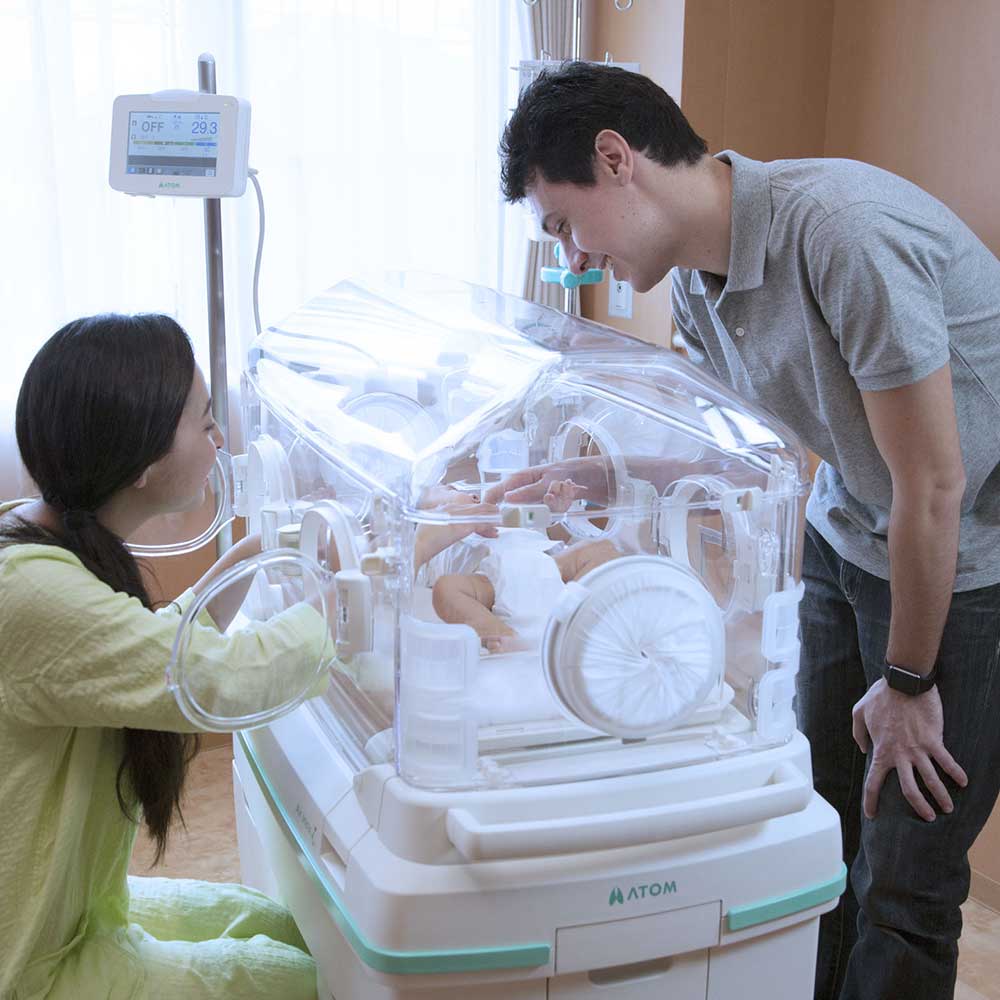
Content
What are they for and what is it
Babies are considered premature if they were born as a result of premature birth and are low in weight. According to WHO standards from 1979, a child born at 22 weeks of gestation and weighing over 500 grams is considered viable. However, such children do not know how to breathe on their own and maintain the required body temperature on their own, his lungs are not opened and the sucking and swallowing reflexes are not formed. Therefore, it is vital for them to be in the neonatal incubator for several hours, and sometimes weeks, until a stable state and the ability to survive without additional conditions created for recovery and development.
A chamber made of organic transparent glass, equipped with electronic devices for monitoring the patient's condition, is a necessary equipment for maternity hospitals and intensive care units for newborns. Modern advances in medicine allow nursing children from 500 grams, but for this you need to fulfill a number of conditions. If a baby is born prematurely, there may be health problems due to the immaturity of some organs. Accordingly, it is necessary to create conditions in which it will "ripen", identical to those in which it should still be. In addition, there are a number of pathologies in full-term babies, when it is necessary to take urgent measures and temporarily place him in an incubator with a microclimate for his comfortable finding, and sometimes to save the life of a small patient.
As a rule, modern models maintain an optimal temperature regime, create the necessary air humidity and oxygen saturation in the specified parameters (its excess is just as dangerous for the baby's health as the lack). In addition, the electronic system allows you to monitor the indicators of the internal environment of the incubator and the state of the child, and if something goes wrong, signal it to the medical staff.
Origin story
The very first couveuse appeared in France in 1878 - obstetrician Stéphane Tarnier asked the zoo caretaker to build a special box on the same principle as an incubator for chickens, but with the aim of placing newborn children there. A little later, in 1880, the Parisian obstetrician Pierre Boudin proposed to introduce heating of such a box, since premature babies died, first of all, due to the inability to keep warm. This worked and reduced the number of infant mortality, which is why Budin is considered the progenitor of neonatology. That old equipment could already warn the staff about the patient's elevated temperature by means of a sound signal. In addition, there were nutritional problems and the risk of infectious diseases in these children.In order to eliminate them, a special probe was used to provide nutrition. Observing sterility to prevent infections, sick babies were kept separate from healthy ones.
In addition, Pierre Boudin took into account the psychological component in nursing a baby - the child needs the presence of the mother. The device was designed in such a way that the mother could observe the baby and, if there were no problems with sucking and swallowing, breastfeed him.
In the future, the development of the kuvez is associated with not entirely ethical actions. Budin's student, Martin Cooney, used this invention as an attraction at the World's Fair in Berlin. To demonstrate the equipment, he "rented" 6 early-born babies at a hospital for the poor. In the future, he continued this tradition, and organized a similar one in New York, which operated on a permanent basis, and began to conduct them in different states of the United States. The project existed from 1901 to 1940, showed about 5,000 patients and was a commercial success. Cooney tried to treat some of these children, although initially his interest was precisely in money. Nevertheless, all of these actions have become the impetus for the creation of premature units in America.
Modern incubators are heated boxes, closed with transparent caps, in which there are four windows for medical manipulations. They are equipped with a ventilator to ensure patient breathing. High air humidity, thermoregulation ensure its vital activity. In addition, modern models have such devices as: built-in scales and photolamps, a shelf for an X-ray cassette, a nasogastric tube for feeding - everything to comply with the principle of "least outside interference". Measuring devices and sensors, to which the patient is connected using various tubes and wires, monitor his heartbeat, body temperature, respiration and other functions and give a signal in case of a deviation from the norm.
Thus, an incubator for newborns is a necessary equipment for all medical institutions where newborns may be located, and the functionality of which is, first of all, to preserve children's life and minimize the negative consequences of premature birth.
What are
How to choose the necessary neonatal equipment and which incubator is better to buy? In order not to make mistakes when choosing, you need to take into account that there are different types of this equipment and pay attention to the description, characteristics and classification. Modern incubators differ in the design details and functions that are available to them. General and basic - resuscitation and warming - are common to all types. Creating more and more advanced models, the developers are guided by the requests and reviews of customers, as well as the recommendations of experienced neonatologists and try to provide all the nuances that provide not only the basic functions, but also allow you to perform all the necessary medical procedures with maximum comfort and safety for both parties.
Doctors in hospitals prefer to use multifunction cameras for quality work, but other equipment is popular. They can be divided into:
- transport (used in ambulances);
- stationary (used in hospitals).
Transport vehicles are equipped with an energy source, which allows their functioning in an autonomous mode, and a ventilator. Their main difference is special technical equipment for infusion therapy. They are used for the safest transportation of critically ill patients to another medical facility.
Stationary ones do not involve frequent movement and, in turn, are subdivided into subspecies:
- classic (with basic functions);
- transformers (converted to an open system);
- multifunctional.
- Classic ones, performing the main purpose, support thermoregulation and air humidity automatically, when opening the openings for procedures, an air curtain is created, and it is also possible to change the inclination of the mattress and install a cassette for X-ray images.
- Transformers allow you to change the design, turning it from closed to open in emergency situations for urgent resuscitation measures. Due to the possibility of functioning not only from the mains, but also from the battery, they are used to transport the patient to the place of surgery. In addition, the camera can be turned into a crib, providing full closeness to the mother, which has a positive effect on the baby's health.
- Multifunctional models combine basic functions and advantages of other types. They are hermetically sealed, have a stable microclimate and allow carrying out any medical measures without transporting an infant, equipped with facilities for infusion therapy, artificial lung ventilation, phototherapy and computer control over the measures taken. They are also equipped with an auto-leveling function and are equipped with ports and shelves for equipment and necessary equipment. Another advantage is the possibility of air removal in order to transport the patient to another medical institution.
Thus, the intended conditions and purposes of using the medical device should influence the selection criteria.
Where to buy and how much does it cost
Of course, this purchase should be planned carefully, as it is not cheap, but, most importantly, the life of a little person depends on its quality and manufacturer's guarantees. As a rule, goods in this category are purchased by medical institutions, orphanages, and high hopes are pinned on it. Therefore, it is advisable to contact specialized medical companies and their online stores, where experienced employees will offer you advice, help you choose from the many presented models of different manufacturers exactly the one that best suits all your requirements, provide warranty service and recommend more favorable terms of purchase - order online or purchase from their store. The price is usually not indicated immediately, but is announced by agreement, because it may vary from configuration.
Best incubators
Transport
Baby pod ii
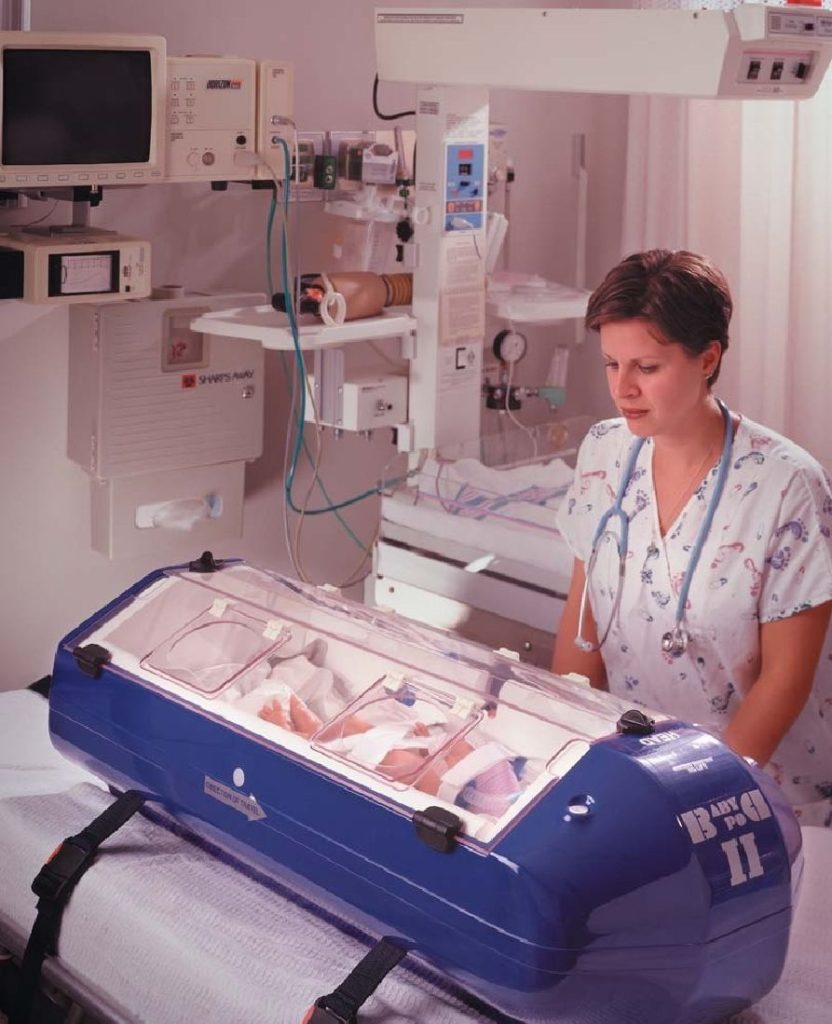
The British-made camera meets all the requirements for safe transportation of an infant to its destination and has successfully passed crash tests. Light enough for this kind of equipment - 9 kg - the model provides a comfortable journey for the patient, secured by a soft strap on the shock-absorbing inner surface. Equipped with all basic functions. Manufacturing material - carbon fiber, allows the possibility of MRI of a child in the equipment. This is what distinguishes this model from identical Swiss, South Korean or Czech production. Recommended for carrying children weighing up to 9000 grams. Advanced Healthcare Tech, the company behind the product, guarantees quality transportation in all conditions, including air travel and turbulence, with ongoing therapeutic care needed. Cost - by agreement and request.
Advantages:
- equipped with a fan and a monitor;
- vacuum mattress with warming gel;
- lightweight, compact;
- safety;
- the possibility of MRI.
Disadvantages:
- not found.
Lullaby TR

The camera of the American company GE is an absolutely safe and efficient incubator that meets all production standards. Permanent computer control over the child, a functional interface, automatic adjustment of the mattress tilt, the ability to install built-in scales and conduct an irradiation session with a UV lamp, a tray, which can be pulled out, you can get X-rays - everything is provided for the convenience of the staff and maximum patient relaxation.The device does not require complex maintenance, thanks to the removable camera. Guardrails provide additional safety for the child. Average price is negotiable.
Advantages:
- easy access to the baby;
- the presence of a mobile cart;
- ease of use;
- parameter measurement accuracy;
- oxygen supply control;
- long battery life - up to 4 hours.
Disadvantages:
- no complaints were received.
STI 5400 / ITI 5400
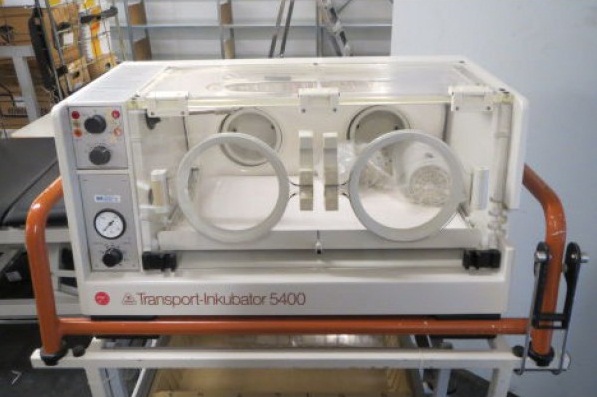
The transport system of German production by Dräger Medical is equipped with all the necessary and additional devices for long-term operation in any type of ambulance transport with the possibility of emergency medical manipulations. The device has built-in ventilation, aspiration and monitoring systems. Negotiated price.
Advantages:
- impeccable equipment;
- safety and reliability;
- ample opportunities for use in any type of transport;
- shock absorbers;
- modularity of construction;
- power supply from the storage battery.
Disadvantages:
- not found.
Stationary
Giraffe

Equipment from GE Healthcare (USA) belongs to the latest generation of incubators for saving the lives of critically ill newborns. New - a rotating mattress that provides access to the patient without disturbing him. Possibilities of conducting an X-ray through the surface of a transparent cap, emergency intervention, adjusting the level of light, temperature, humidity and oxygen by personnel in accordance with the doctor's recommendations. The baby placed in this incubator is safe and stable. With the air curtain function, it is protected from hypothermia even when the windows are opened. The price depends on the equipment configuration.
Advantages:
- silent operating mode;
- patented rotating mattress;
- the ability to customize the system parameters in accordance with the needs of the patient;
- ease of use.
Disadvantages:
- not found.
Lullaby XP
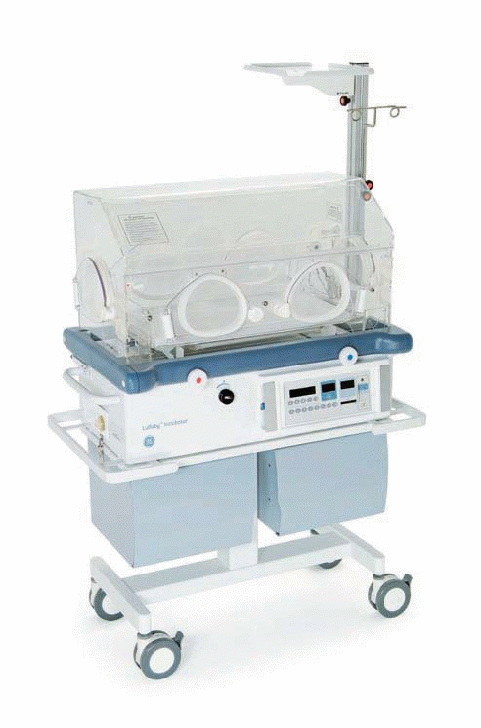
The medical equipment of the American manufacturer allows to create optimal conditions for young critically ill patients, necessary for their full growth and development. The simplicity of the interface frees the medical staff from manipulating the system, allowing you to deal directly with the child. It has all the basic functions and is equipped with such additional options as automatic regulation of oxygen and humidity, low noise level, the ability to change the position of the mattress, a drawer for X-rays. Cost by agreement.
Advantages:
- easy system control;
- quiet environment;
- the ability to create comfortable conditions for the newborn.
Disadvantages:
- not found.
Transformers
Atom Incu I
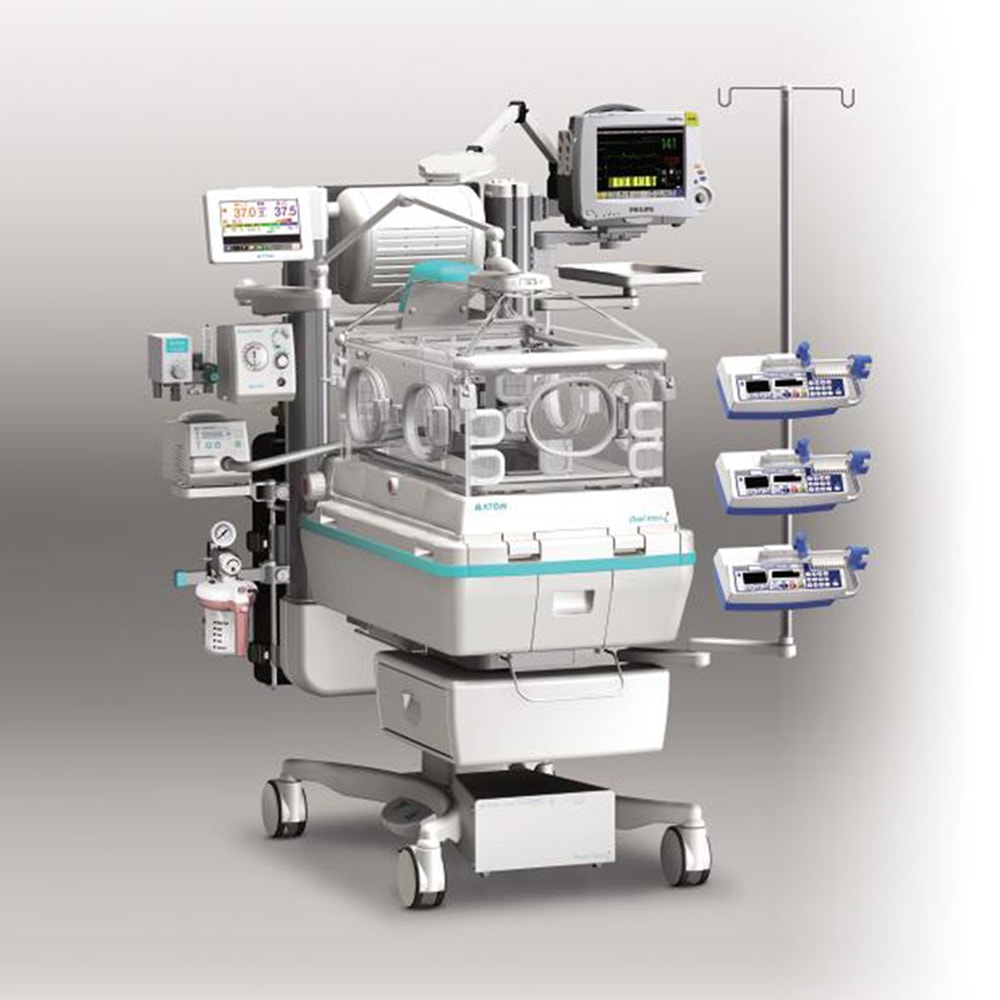
The Japanese-made model can be used both for carrying a child and stationary. A built-in resuscitation system is provided for emergency medical intervention. The incubator meets the standards and provides ideal conditions for nursing a newborn. The compactness of the model does not complicate transportation, it works from a network or a power supply. The transformation of the incubator into the resuscitation system is carried out very quickly. For procedures in a dark room or transport, it is proposed to purchase an LED lamp included. Price on request.
Advantages:
- improved air circulation system;
- multifunction display;
- built-in devices for the possibility of carrying out care and treatment without disturbing the patient;
- ease of use.
Disadvantages:
- not detected.
Atom Rabee Incu I

Another product from Japan with an accessible interface and maximum newborn rescue capabilities. The parameters set by the operator provide an ideal microclimate for the baby. The door lock guarantees complete safety, but does not impede access to the child if necessary. Double walls minimize the heat loss of the newborn. Cost by agreement.
Advantages:
- low noise level;
- cassette humidification system;
- locking system;
- double walls;
- heating panels;
- adjustable mattress tilt;
- guarantee of safety and efficiency.
Disadvantages:
- absent.
Dräger babyleo
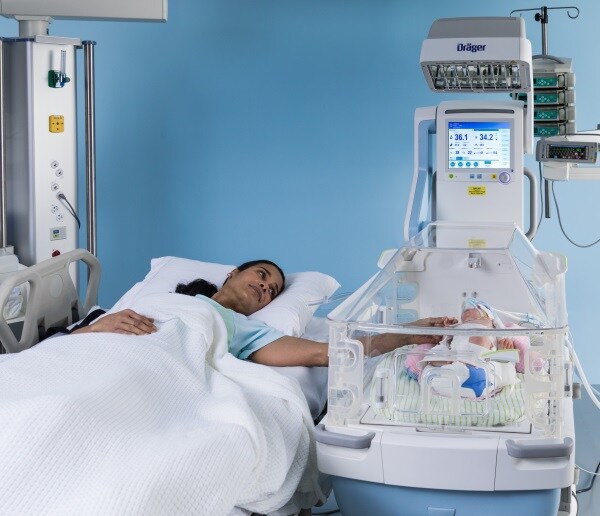
A novelty in neonatology, Dräger's IncuWarmer equipment has been created in accordance with all recommendations for nursing premature babies and allows you to recreate the effect of the mother's womb, which is natural for the histological age of the infant. The device has all the necessary systems, many of which are improved and have no analogues. For example, one of the unprecedented solutions is the ability to reproduce the heartbeat and voice of the mother using the audio stimulation function, which creates a natural environment for the premature baby, stimulates its development and stabilizes the psychological state. The popularity of the model is due to innovative solutions for the implementation of standard functions. Price by agreement.
Advantages:
- additional heat therapy;
- simplified workflow;
- provides almost real intrauterine development;
- guarantees the prevention of infections;
- family-oriented approach.
Disadvantages:
- absent.
Currently, work is constantly underway to improve the existing models of incubators that contribute to nursing healthy children and minimize their disability.

The editors of the site "bestx.htgetrid.com/en/" presented readers with an overview of the best incubators for babies for 2020. We hope the information was useful to our readers.












